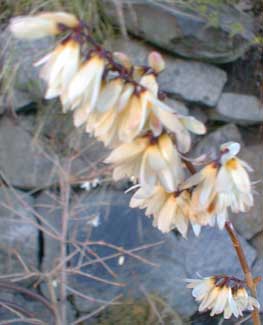
White Forsythia; aka
Korean Abelea-leaf
"I had forgotten the gesture of branches
Suddenly white,
And I had forgotten the fragrance of blossoms
Filling a room at night."
Hazel Hall
(1886-1924)
(1886-1924)
White forsythia or Korean Abelea-leaf (Abeliophyllum distichum) was first described in 1919 by Professor Takenoshin Nakai. The only species in its genus, white forsythia is not a true forsythia, but it is a member of the olive family, as is forsythia.
Seeds reached the Arnold Arboretum in 1924, & Kew Gardens by 1932. It was soon discovered to be so easily cultivated that it almost immediately found its way into American & English gardens. In 1937 it received the Award of Garden Merit from the Royal Horticultural Society.
Purplish buds all along the grey naked branches open into faintly almond-fragrant small white four-petalled flowers occasionally with a faint pink shimmer & yellow stamins. These burst into bloom late in winter, typically for February & March, but the photo here is from the third week in January (2006) when we'd had a warmish & very wet winter.
It blooms before the reappearance of its leaves & it blooms well ahead of our yellow true forsythias. Like true forsythia, limbs of winter buds can be brought indoors to open sooner in vases.
These late winter flowers can be showy despite their small size, since there are not yet leaves to hide them. The little blooms can occur in racemes of three to fifteen & become very showy indeed, but if a shrub is young or conditions a bit harsh, it will have only a sprinkling of singular flowers. It has a slow to moderate growth rate to four or five feet high & wide, very twiggy in its winter appearance.
After the flowers are vanishing & the glossy green leaves appearing, some gardeners find the leafy shrub a tad boring. I think its abelea-like leaves are attractive, & it makes an excellent addition to a mixed border of shrubs. The flowers also produce small winged fruits similar to those on elms.
This native to a small area of central Korea is a seriously endangered species in the wild, but will never be extinct in gardens. The fact that it is regarded as a medicinal plant in Korea has put great presures on wild populations which are illegally harvested for the enormous black market in herbal medicines. The leaves do produce a number of glycysides & may have the same valid values as witchhazel, though the evidence isn't as clear as it is for witchhazel.
In the northwest it wants full sun but can tolerate partial shade. Inland or further south it would want partial sun to partial shade. It's fairly low-maintenance just so long as it gets medium watering. It is not fussy about soil conditions but will not do well in a droughty spot.
Ideal for zones 6 through 7 & Northwest Zone 8, it can also succeed in zones 4 & 5 with protection from desicating winter winds, or up close to a house for residual warmth.
It's easily propogated from softwood cuttings. It likes a post-flowering pruning to induce new growth & assist its production of flowering wood for the following year.
As much as a third of the oldest branches can be annually shortened or removed, then every third or fourth year it can be hard-pruned to near the ground. The cuttings from pruning can be touched at the cut with rooting hormone & protected in coldframes or starter-pots.